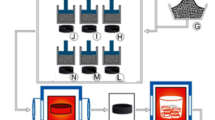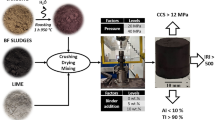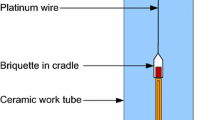Abstract
In this study, composite briquettes were prepared using gravity dust and converter sludge as the main materials; these briquettes were subsequently reduced in a tube furnace at 1000–1300°C for 5–30 min under a nitrogen atmosphere. The effects of reaction temperature, reaction time, and carbon content on the metallization and dezincification ratios of the composite briquettes were studied. The reduced composite briquettes were characterized by X-ray diffraction (XRD), scanning electron microscopy (SEM), and energy-dispersive spectroscopy (EDS). The results show that the gravity dust and converter sludge are combined into the composite briquettes and a reasonable combination not only improves the performance of the composite briquettes, but also leads to the reduction with no or little reductant and flux. As the reaction temperature is increased and the reaction time is extended, the metallization and dezincification ratios of the composite briquettes increase gradually. When the composite briquettes are roasted at 1300°C for 30 min, the metallization ratio and dezincification ratio reaches 91.35% and 99.25%, respectively, indicating that most of the iron oxide is reduced and the zinc is almost completely removed. The carbon content is observed to exert a lesser effect on the reduction process; as the C/O molar ratio increases, the metallization and dezincification ratios first increase and then decrease.
Similar content being viewed by others
References
S. Kelebek, S. Yörük, and B. Davis, Characterization of basic oxygen furnace dust and zinc removal by acid leaching, Miner. Eng., 17(2004), No. 2, p. 285.
Y.X. Chen and W.J. Feng, Research on the centralized treatment and comprehensive utilization of metallurgical dust, Sintering Pelletizing, 30(2005), No. 5, p. 42.
B.C. Liu, G. Wei, F.M. Shen, and Q.J. Zhao, Comprehensive utilization and management of dust and sludge as resource in iron and steel plants, J. Mater. Metall., 5(2006), No. 3, p. 231.
S.A. Mikhail and A.M. Turcotte, Thermal reduction of steel-making secondary materials: I. Basic-oxygen-furnace dust, Thermochim. Acta, 311(1998), No. 1–2, p. 113.
F.W. Su, H.O. Lampinen, and R. Robinson, Recycling of sludge and dust to the BOF converter by cold bonded pelletizing, ISIJ Int., 44(2004), No. 4, p. 770.
M.V. Cantarino, C. de C. Filho, and M.B. Mansur, Selective removal of zinc from basic oxygen furnace sludges, Hydrometallurgy, 111–112(2012), p. 124.
L.N. Fu and L.M. Kang, Study and practice of adding BOF sludge to replace bentonite in Tanggang shaft furnace pelletizing, Sintering Pelletizing, 26(2001), No. 6, p. 16.
D. Senk, H.W. Gudenau, S. Geimer, and E. Gorbunova, Dust injection in iron and steel metallurgy, ISIJ Int., 46(2006), No. 12, p. 1745.
H. Oda, M. Takahashi, and T. Ibaraki, Dust recycling technology by the rotary hearth furnace, Nippon Steel Tech. Rep., 86(2002), p. 30.
T. Harada, H. Tanaka, and H. Sugitatsu, FASTMET process verification for steel mill waste recycling, Kobelco Technol. Rev., 24(2001), p. 26.
H.T. Makkonen, J. Heino, L. Laitila, A. Hiltunen, E. Pöyliö, and J. Härkki, Optimisation of steel plant recycling in Finland: dusts, scales and sludge, Resour. Conserv. Recycl., 35(2002), No. 1–2, p. 77.
X.F. She, Q.G. Xue, J.S. Wang, and L.T. Kong, Comprehensive utilization of zinc-bearing dust and comparison of treatment processes, Ironmaking, 29(2010), No. 4, p. 56.
B. Das, S. Prakash, P.S.R. Reddy, and V.N. Misra, An overview of utilization of slag and sludge from steel industries, Resour. Conserv. Recycl., 50(2007), No. 1, p. 40.
S. Pipatmanomai, A.A. Herod, T.J. Morgan, N. Paterson, D.R. Dugwell, and R. Kandiyoti, The fate of volatiles from injectant coals and soot formation in blast furnaces, Energy Fuels, 18(2004), No. 1, p. 68.
U. Leimalm, M. Lundgren, L.S. Ökvist, and B. Björkman, Off-gas dust in an experimental blast furnace: Part 1. Characterization of flue dust, sludge and shaft fines, ISIJ Int., 50(2010), No. 11, p. 1560.
G.X. Qiu and Q.X. Shi, Research on reduction and enrichment of ferronickel from laterite-nickel ores using carbon as reductant, Min. Metall. Eng., 29(2009), No. 6, p. 75.
M. Xu, Z.X. Zhao, J.L. Zhang, L.T. Kong, and T.J. Wan, Behaviour of reduction, melting and separation in ore/coal composite pellets, J. Iron Steel Res., 19(2007), No. 10, p. 11.
Author information
Authors and Affiliations
Corresponding author
Rights and permissions
About this article
Cite this article
Xia, Lg., Mao, R., Zhang, Jl. et al. Reduction process and zinc removal from composite briquettes composed of dust and sludge from a steel enterprise. Int J Miner Metall Mater 22, 122–131 (2015). https://doi.org/10.1007/s12613-015-1052-8
Received:
Revised:
Accepted:
Published:
Issue Date:
DOI: https://doi.org/10.1007/s12613-015-1052-8




